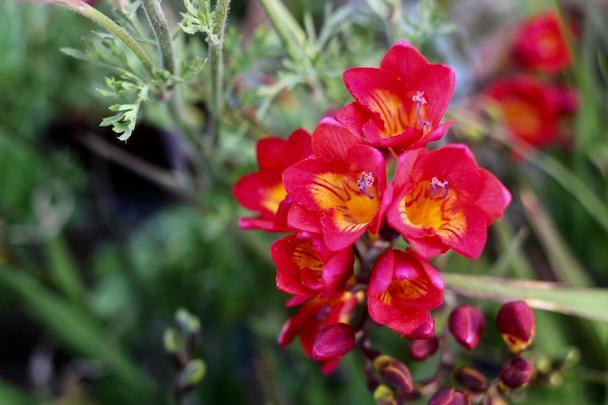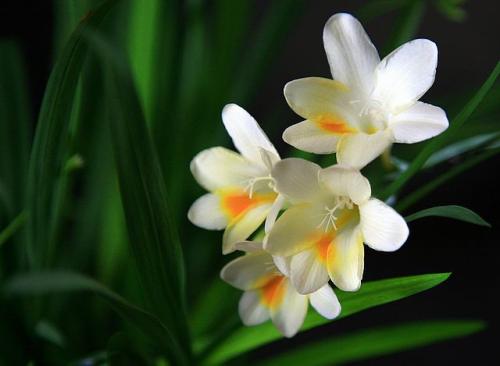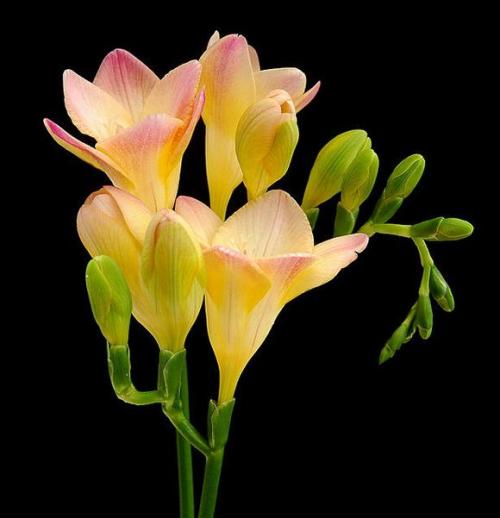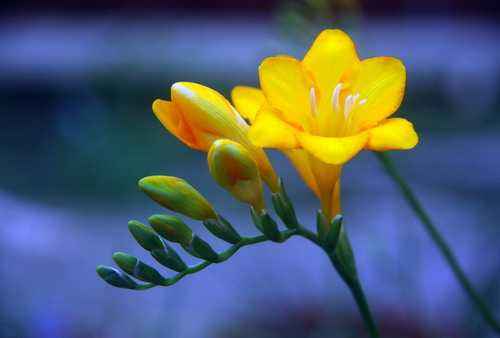Freesia hybrida Klatt. profile
Written by Maggie
Jan 19 2021

Freesia hybrida Klatt. is a perennial bulbous herbaceous flower belonging to the genus Lilium, Iridaceae, and Vanilla. The bulb is narrowly ovate or ovoid, the leaf is sword-shaped or strip-shaped; the flower stem is erect; the flower is erect and sessile, light yellow or yellow-green, fragrant, bracts broadly ovoid or ovoid, perianth tube trumpet-shaped. The lobes are oval or elliptic, the capsule is nearly ovoid, flowering in April and May, and fruiting in June and September.
Freesia hybrida Klatt picture

Morphological characteristics of Freesia hybrida Klatt.
Freesia hybrida Klatt. is a perennial bulbous herb flower. The bulbs are narrowly ovoid or ovoid, with a thin film coating on the coating, with net patterns and dark red spots on the coating. The leaf is sword-shaped or strip-shaped, slightly curved, 15-40 cm long, 0.5-1.4 cm wide, yellow-green, with obvious midrib.
Freesia hybrida Klatt. The flower stem is upright, with 2 to 3 curved branches on the upper part and several leaves on the lower part; the flowers are sessile; each flower has 2 membranous bracts at the base, and the bracts are broadly ovate or ovoid, top Slightly concave or 2-pointed, 0.6 to 1 cm long and 8 mm wide; flowers are upright, light yellow or yellow-green, scented, 2 to 3 cm in diameter; perianth tube is flared, about 4 cm in length, and about 1 in diameter Centimeters, the base becomes thinner, the perianth lobes are arranged in 6, 2 rounds, the outer perianth lobes are oval or elliptical, 1.8 to 2 cm long and 6 mm wide, the inner one is slightly shorter and narrower than the outer perianth lobes.The capsule is nearly ovoid, and the dorsal cavity is dehiscent. Flowering preiod is from April to May, fruiting from June to September.
The habitat of Freesia hybrida Klatt.
Freesia hybrida Klatt. is native to southern Africa. Open-air cultivation is common in southern China, and potted plants are common in northern China.
Growth habits of Freesia hybrida Klatt.
Freesia hybrida Klatt. likes a cool, humid environment with sufficient light, and has poor cold tolerance. The suitable temperature for growth is 15℃~20℃, and the minimum temperature for overwintering is 3℃~5℃. The large temperature difference between day and night is conducive to growth and development. The temperature at night should be 10℃~15℃, and it should not exceed 20℃ during the day, otherwise the growth will be poor. Prefers loose soil with good drainage and rich in humus.
During the growth of freesia hybrida Klatt., the bulb can promote rooting and germination at 13.5℃~15℃. Differentiation requires a low temperature of 8℃~13℃. During the flower bud development period, the suitable temperature is 13℃~18℃. If the temperature is lower than 18℃, the flowering period will be delayed and the flower stem will be shortened. Higher temperatures can promote early flowering, but plant growth is weak.
Freesia hybrida Klatt. is beneficial to promote flower bud differentiation under short-day conditions. After the flower buds differentiate, the long-day light can bloom earlier. Usually the bulbs are sown in September, and the flower buds begin to differentiate in early November, and the differentiation is completed in late November. After the plant arrives in May of the following year, the leaves gradually wither and the bulb enters a natural dormancy period.

Freesia hybrida Klatt. breeding method
The propagation method of Freesia hybrida Klatt. is divided into sowing and split-ball propagation.
sowing
Cut flower varieties can be propagated by seeds. Collect seeds in time after the seeds mature from May to June. Otherwise, the capsules will crack, the seeds will be lost, and the seeds have no dormancy habit, so they can be sowed immediately after harvest. The optimum temperature for Freesia hybrida Klatt. seed germination is 15-20 ℃, and it will germinate neatly under dark conditions for about 21 days. When the seedlings have 5 to 7 leaves, the above ground is withered and the underground bulb enters a high temperature dormancy period. After dormancy, planting and cultivating seed balls for 1 year can be used as flowering cue balls.
Using containers to raise seedlings can get flowering balls in one year. The specific method is: after the seeds are harvested from May to June, they will be sown in the greenhouse. After the seedlings emerge, they will be cultivated in the greenhouse. Keep the room temperature at 15~18℃. Give Freesia hybrida Klatt. good water and fertilizer. Until May to June of the following year, the ball diameter It can reach more than 1 cm and can be used directly as flowering bulbs.
Split ball
Generally 4 to 6 child balls of Freesia hybrida Klatt. can be born around the cue ball, which is dug up during the summer dormancy period, and the child balls are separated from the cue ball and stored, and sowed in autumn. As cut flower cultivation bulbs, bulbs with a stem circumference of 8 cm or more are required to ensure the quality of cut flowers. The method of cultivating seed balls is to dig up and store the seed balls during the dormant period in summer: by early August, the seed balls can be planted in pots. The soil can be 30% decomposed organic fertilizer, and then the cultivated soil can be put into the pot. , Then plant the ball in a pot, and cover the ball with 1 to 1.5 cm of soil. After planting, it should be watered thoroughly, and it will germinate and grow after 10 days, and will develop into bulbs in May of the second year.

The main value of Freesia hybrida Klatt.
Watch
There are many gardening varieties for indoor ornamental flowers in spring. Commonly used potted plants or cut Freesia hybrida Klatt. flower branches to decorate the room, it is an ideal potted plant to decorate the living room and study room.
Medicinal
Freesia hybrida Klatt.’s bulb has the effects of clearing away heat, detoxifying, and promoting blood circulation. For snake wounds and sores.
Latest Updated
- Benefits of Bugleweed - 7 Science-backed Health Benefits
- Bugleweed Dangers & Side Effects - Is It Poisonous?
- How to Plant Evergreen Trees - What You Should Know
- When to Plant Evergreens - Grow Guide for Evergreen Trees
- 12 Wonderful Evergreen Shrubs for Your Garden
- 12 Popular Evergreen Plants with Pictures for Beginners
- When And How To Prune A Lilac Bush Like a Pro
- How to Grow & Care for Lilac Vine (Hardenbergia Violacea)
- Japanese Lilac Tree (Syringa Reticulata) Care & Propagation Guide
- Shumard Oak Pros and Cons - What to Know
Popular Articles
- Winter maintenance of Antirrhinum Majus
- How to Grow Terminalia Mantaly Tree
- How to Grow and Care for Crossostephium Chinense
- How to grow Antirrhinum Majus in spring
- Peristeria Elata (Dove Orchid) Profile: Info & Care Guide
- Underwatered Snake Plant (Sansevieria Trifasciata) - Signs And How To Fix
- How to Care for Brazilian Jasmine Plant (Mandevilla Sanderi)
- How to Grow & Care for Graptopetalum Purple Delight in Summer
- Rosa Chinensis (China Rose): Plant Growing & Care Tips
- How to Care for Baby Sun Rose (Aptenia Cordifolia)